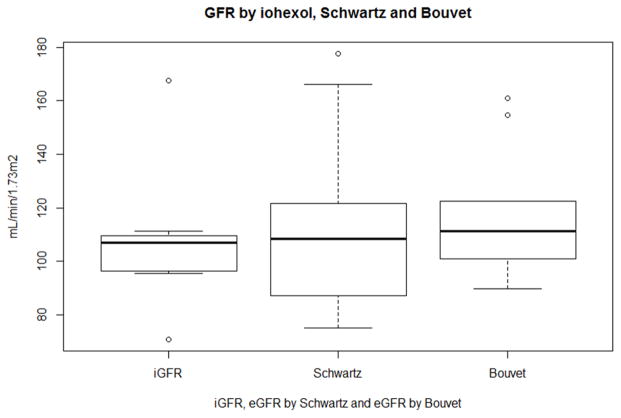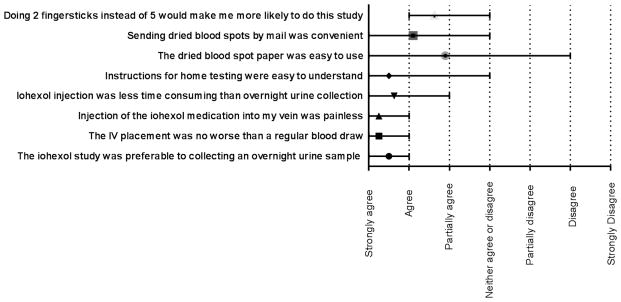The American Diabetes Association recently recommended routine screening of glomerular filtration rate (GFR) in adolescents with type 1 diabetes, although this is not routinely performed clinically (1, 2). Current estimates of GFR lack precision and accuracy before stage 3 of chronic kidney disease (GFR < 60 mL/min/1.73m2) (3). Also, measurement of urinary albumin excretion, currently recommended as part of routine screening, does not directly measure kidney function. This is of particular concern in adolescents and young adults with type 1 diabetes, in whom renal hyperfiltration may promote renal injury, or rapid change in GFR may be missed due to lack of acceptable screening methods for GFR. Perrin et al. recently reported that estimated GFR cannot accurately replace measured GFR to defect hyperfiltration in young patients with type 1 diabetes (4).
We recently reported that iohexol clearance measured with dried blood spots (DBS) on filter paper performed better than the estimates of GFR using the CKD-EPI equations and was comparable to gold-standard iohexol plasma clearance in adults with type 1 diabetes (5). GFR measured by iohexol clearance on DBS has also been evaluated in adults with a wide range of GFRs showing strong agreement to gold-standard measurements (6). Standard iohexol GFR (iGFR) measurement requires more than 4 hours in a research center making it impractical for routine clinical monitoring of GFR.
Here we present data from a pilot study in youth with type 1 diabetes (n=8, 70% female, 17±4 years, type 1 diabetes duration of 6.3±5.0 years, HbA1c 8.9±2.5%) with the goal of demonstrating feasibility of translating this method to an ambulatory setting. Kidney function was measured by iGFR with DBS and estimated by Bouvet (cystatin C and creatinine-based GFR equation) and Schwartz (creatinine-based GFR equation). The participants had blood drawn then iohexol injected intravenously prior to their regular diabetes visit and were sent home with filter paper to collect DBS at 120, 150, 180, 210 and 240 minutes after iohexol injection followed by mailing the filter paper back to our lab.
There appeared to be less variability of GFR with the iGFR than the estimated GFR methods (Bouvet and Schwartz) (Figure 1). As this study was performed on an out-patient basis to determine feasibility, we did not perform an in-patient gold-standard iGFR study to serve as a comparator for these 3 GFR measurements. However, our previous publication in adults with type 1 diabetes demonstrated that iGFR measured in DBS on filter paper was significantly less biased and more comparable to a gold-standard iGFR measurement than estimated GFR (5). Moreover, using 2 spots at 120 and 240 minutes was comparable to using 5 spots (5), which if validated would further decrease burden to the patient and cost of this method. The adolescents also rated eight statements on a 7-point non-validated Likert scale (Figure 2). All participants agreed or strongly agreed that the procedure was preferable to collecting an overnight urine sample. There are important limitations to the present study worth mentioning, including the small sample size and the lack of a gold-standard iGFR for comparison. However, our aim was not to compare iGFR measured in DBS on filter paper with gold-standard iGFR, which we have previously done, but rather evaluate the feasibility of this methodology in an ambulatory setting in adolescents with type 1 diabetes.
Figure 1.
Mean GFR by iohexol, Schwartz and Bouvet
Figure 2.
Likert Scale Questionnaires
Adapting this methodology to an out-patient setting by measuring iohexol clearance, as was also recently reported in a Kenyan population (7), to assess GFR in youth with type 1 diabetes requires further study to determine if it addresses the current need to better screen for early diabetic kidney disease.
Acknowledgments
We would like to thank the study participants and their families as well as the staff of the Colorado Antiviral Pharmacology Laboratory and the Barbara Davis Center for Childhood Diabetes for making this study possible. Support for this study was provided by an Innovative Grant from the Juvenile Diabetes Research Foundation 5-2013-122.
Dr. Bjornstad and Maahs are guarantors of this work and, as such, had full access to all the data in the study and take responsibility for the integrity of the data and the accuracy of the data analysis.
Footnotes
Author Contributions
PB and DMM researched, wrote, formulated analytic plan, contributed equally to discussion and analytic plan, and reviewed/edited the manuscript. PLA provided the analytical measurements and reviewed/edited the manuscript.
Ethical standards
All procedures followed were in accordance with the ethical standards of the responsible committee on human experimentation (institutional and national) and with the Helsinki Declaration of 1975, as revised in 2008. Informed consent and assent were obtained from all patients included in the study.
Conflict of interest
The authors declare that they have no conflict of interest.
References
- 1.Chiang JL, Kirkman MS, Laffel LM, Peters AL. Type 1 diabetes through the life span: a position statement of the American Diabetes Association. Diabetes Care. 2014;37(7):2034–54. doi: 10.2337/dc14-1140. Epub 2014/06/18. [DOI] [PMC free article] [PubMed] [Google Scholar]
- 2.Professional Practice Committee for the Standards of Medical Care in Diabetes-2015. Diabetes Care. 2015;38(Supplement 1):S88–S9. Epub 2014/12/30. [Google Scholar]
- 3.Inker LA, Schmid CH, Tighiouart H, Eckfeldt JH, Feldman HI, Greene T, et al. Estimating glomerular filtration rate from serum creatinine and cystatin C. The New England journal of medicine. 2012;367(1):20–9. doi: 10.1056/NEJMoa1114248. Epub 2012/07/06. [DOI] [PMC free article] [PubMed] [Google Scholar]
- 4.Perrin NE, Berg UB. Estimated glomerular filtration rates cannot replace measured GFR in type 1 diabetes patients with hyperfiltration. Acta Paediatr. 2015 doi: 10.1111/apa.12993. Epub 2015/03/06. [DOI] [PubMed] [Google Scholar]
- 5.Maahs DM, Bushman L, Kerr B, Ellis SL, Pyle L, McFann K, et al. A practical method to measure GFR in people with type 1 diabetes. Journal of diabetes and its complications. 2014;28(5):667–73. doi: 10.1016/j.jdiacomp.2014.06.001. Epub 2014/07/17. [DOI] [PubMed] [Google Scholar]
- 6.Niculescu-Duvaz I, D’Mello L, Maan Z, Barron JL, Newman DJ, Dockrell ME, et al. Development of an outpatient finger-prick glomerular filtration rate procedure suitable for epidemiological studies. Kidney international. 2006;69(7):1272–5. doi: 10.1038/sj.ki.5000240. Epub 2006/04/13. [DOI] [PubMed] [Google Scholar]
- 7.Margolick JB, Jacobson LP, Schwartz GJ, Abraham AG, Darilay AT, Kingsley LA, et al. Factors affecting glomerular filtration rate, as measured by iohexol disappearance, in men with or at risk for HIV infection. PloS one. 2014;9(2):e86311. doi: 10.1371/journal.pone.0086311. Epub 2014/02/12. [DOI] [PMC free article] [PubMed] [Google Scholar]




